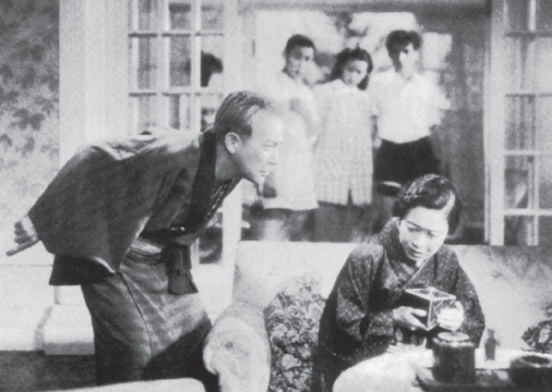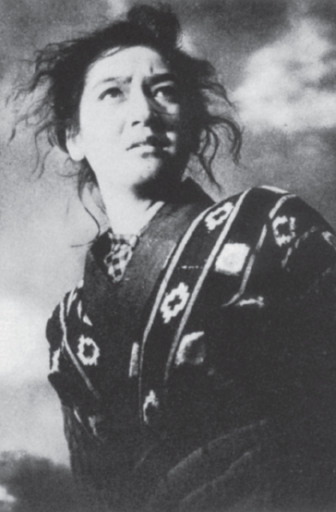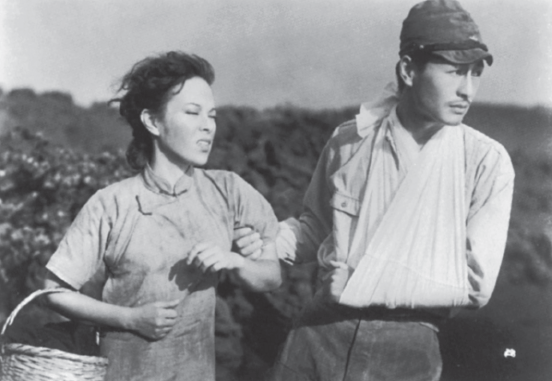In August 1945, Japan surrendered unconditionally to the Allied nations, bringing the Second World War to an end. For Japan, this marked the end of a long fifteen years of war, a period that began with the military invasion of northeast China in 1931. In September 1945, GHQ1 rule over Japan began, and it continued until 1952. Japan lost its colonies—Korea, Taiwan, and the islands in the South Pacific—and Okinawa was seized and put under the jurisdiction of American military powers. As a result of the loss of these colonies, the Japanese Empire lost any obvious trace of ethnic and cultural diversity, and the postwar ideology of Japan as an ethnically homogenous, unified linguistic unit gained currency. Emperor Hirohito made his declaration that he was human, and the emperor became a symbol of the state under the new constitution. It was the beginning of so-called postwar democracy.
Thanks to the efforts of his father, Kurosawa Akira avoided going to war. He was in the middle of filming The Men Who Tread on the Tiger’s Tale (Tora no o o fumu otokotachi, 1945) when the war ended. He ignored the end of the war and managed to continue until the film was complete, but he was not allowed to screen the film publicly. Tasaka Tomotaka was exposed to radiation at Hiroshima, and as a result, endured a painful struggle against the illness that lasted many years. He accepted this as retribution for his transgressions. Mizoguchi Kenji completely lost all sense of direction, while his disciple, Shindō Kaneto, welcomed the arrival of a new age. Makino Masahiro quickly took out musical instruments that had been stored away at the studio and hastily organized a jazz band to welcome the occupying army. In a prisoner-of-war camp in Singapore, Ozu Yasujirō watched Hollywood movies day after day. And Uchida Tomu, after witnessing the suicide of Amakasu Masahiko, remained in Manchuria for the following eight years. After he was sent to a mine for labor, he instructed Chinese filmmakers in the use of film technology. This is the way that postwar Japanese cinema began.
In October 1945, Shōchiku released the first postwar Japanese film, Sasaki Yasushi’s A Gentle Breeze (Soyokaze). It featured a huge hit with The Apple Song (Ringo no uta), which Namiki Michiko sings in a fruit orchard in her family home in the countryside far removed from the devastation of Tokyo.
Also in October 1945, the Civilian Information and Education Division (CIE), a subsidiary organization of GHQ, came to manage the entirety of the Japanese film industry. The CIE was given absolute authority over censorship of all the films that were produced. Japanese producers had to have all proposals and scripts translated into English and receive permission before they could begin filming. The completed film underwent a second censorship through the Civil Censorship Detachment (CCD). At the core of the CIE were American civilians, but the CCD was composed of military figures, which meant that ultimately this was military censorship.
On one hand, the United States preached freedom and democracy to the Japanese, but on the other, they resolutely carried out censorship on films that were not advantageous to them. This contradiction affected the entire process, bringing grief not only to Japanese filmmakers but also to the American censors. In addition, the policies of GHQ were clearly different between the beginning and end of the Occupation. Initially GHQ had a socialist orientation and carried out agricultural reform and the dissolution of the zaibatsu economic cartels. At the end of the Occupation, anti-communism was prioritized. The basis of censorship changed in accord with these shifts.
In November 1945, David Conde, the chief of CIE, assembled a list of thirteen things that were banned from Japanese films, based on the perception of wartime Japanese cinema as extolling militarism and renouncing Western individualism. The list began with things that offered praise for nationalism, patriotism, or fealty to feudal thought, but it also included such categories as revenge stories, stories praising suicide, or any works that encouraged cruelty and immoral violence. Finally, as though it were perfectly natural, any film that opposed GHQ directives was also subject to censorship. This latter had no connection with the aforementioned categories and indicated that GHQ could freely ban anything. Incidentally, throughout the Occupation, GHQ took extreme care to hide the fact that this censorship was being carried out.
With this GHQ directive, it became effectively impossible to produce jidaigeki. It is true that there were exceptions, like Kinoshita Keisuke’s Ghost Stories of Yotsuya: A New Interpretation (Shinshaku Yotsuya kaidan, 1949). This work, however, did little apart from applying a weak psychological explanation from a contemporary standpoint to Tsuruya Nanboku’s original Kabuki play. The sense of dynamism and beauty of pathos that are so much a part of prewar jidaigeki as a genre were utterly absent. Jidaigeki without using a sword—conceived as a means of short-circuiting censorship rules—could never earn the support of the masses. As a result, long-time stars of chanbara movies were compelled to move over to gendaigeki films. Kataoka Chiezō played a detective with so many disguises that he was known as the “man with seven faces” in the Tarao Bannai series (1946–1960), and Bandō Tsumasaburō played a caricature of the patriarchal father whose meaning would be merely humorous within postwar society. Curiously, masters of chanbara such as Inagaki Hiroshi and Itō Daisuke directed gendaigeki masterpieces, such as Children Holding Hands (Te o tsunagu kora, dir. Inagaki, 1948) and The Shogi Master (Ōshō, dir. Itō, 1948).

Broken Drum (dir. Kinoshita Keisuke, 1949).
Film censorship by GHQ also applied to past films. With great strictness they inspected those prewar films that managed to survive the wartime firebombing and any scenes considered improper were summarily cut. For this reason, many films, including Mizoguchi Kenji’s The Water Magician (Taki no shiraito, 1933), now exist only in incomplete form. Genroku chūshingura remained intact only because it was immediately confiscated by the United States. It was returned to Japan in complete form twenty years later.
The occupying army did not simply ban a list of forbidden subjects. They actively encouraged production of “idea films,” in the interest of enlightening the population about American-style democracy. Those filmmakers who had hitherto been directed by the military to make films to boost militarism were now being confronted with demands by the United States to shift direction and make works extolling democracy. Let us look at some of these idea films.
No Regrets for Our Youth (dir. Kurosawa Akira, 1946).
Kurosawa Akira’s No Regrets for Our Youth (Waga seishun ni kuinashi, 1946) tells the story of the daughter of a professor who, during the prewar period, is removed from his university post for participating in antiwar movements. The daughter marries one of her father’s pupils—an antiwar activist—and after he dies in prison during the war, she continues his legacy. The daughter in the film—played by Hara Setsuko—lives in a farming village where the family home of her late husband is located and continues to work on the farm trying not to succumb to the persecution directed at her as an antipatriot by angry villagers. With the defeat of militarism, she stands at the head of an agricultural reform movement, struggling to erect a new Japan. The man in charge of the script, Hisaita Eijirō, was a leftist in the prewar period, but he cooperated with the authorities during wartime. It may not be so difficult to read this narrative as one of his personal “regrets of youth.” Some film critics criticized Hara’s performance in the film as being overly stiff. Viewers who were accustomed to Hara playing the bride of a military officer or police officer during the war accepted her with a mixture of confusion and anticipation.
Kurosawa was upset that—under pressure from the labor union of Tōhō, the production company—he had to append a section at the end of the film depicting Hara’s participation in the agricultural reform movement. Looking at it now, however, even though the impetus to include these scenes was leftist, what actually resulted in the final scenes from No Regrets for Our Youth are strikingly similar to those from the Nazi film The New Earth she had starred in nine years earlier. This episode is a good illustration of the nature of postwar leftist movements.
For several years during the occupation, Hara Setsuko enjoyed a reputation as a goddess of democracy. In Yoshimura Kōzaburō’s Ball at the Anjō House (Anjōke no butōkai, 1947), she played the role of the eldest daughter of a family brought down with the collapse of the nobility; she urges her aging father to seek out new ways of living for a new age. In Imai Tadashi’s The Blue Mountains (Aoi sanmyaku, 1949), in the role of a progressive teacher newly assigned to a rural high school, she earns the respect of her students for defeating the feudal powers of the town. Curiously, where Arnold Fanck once unstintingly praised her as the prototypical Japanese woman, Hara was taken as a metaphor for a new Western era for viewers of a defeated nation on account of her large stature. No one publicly criticized her ideological about-face perhaps because, to some extent, in the postwar era, without exception, everyone was forced to make similar accommodations.
As was the case with literature and theater, as well as music, the problem of war responsibility in the world of cinema was intentionally rendered ambiguous, and by the time it was settled at a formal level, people could no longer dare to make any claims. Kamei Fumio, who had endured life in prison after making Shanghai, released A Japanese Tragedy (1946) through Tōhō, in which he handled the conversion of Hirohito from a figure in military garb into a man in a suit with a slow lap dissolve. The claim of this work is that it is the Japanese military that should be prosecuted, while citizens were merely duped by the military. This logic was highly convenient for Japanese people to break off from the past and face a new era. Kamei, who had shown his astonishing skill in deconstructing ideology with Shanghai, fell into mere dogmatism with A Japanese Tragedy. He was unable to interrogate whether the democracy Japanese people were now ostensibly enjoying was truly their own. Incidentally, through the policy of GHQ, screenings of the film were quickly banned and then the film was seized by the United States.
As part of a unified Occupation policy, it was demanded that those who were in a leadership position within the wartime film industries would be purged from all public positions. This accusation, however, was extremely difficult to make. In Japan, unfortunately, there was no one like Elia Kazan to inform on his friends one after another. Thus, a difficult situation arose: whenever they did to try to put together a list of wartime collaborators, those who put people on the list ultimately wound up added to it themselves. Itami Mansaku, who had contributed to Nazi film when he codirected The New Earth, insisted on the impossibility of determining who were war criminals. It was not that the deceivers were bad and that those deceived were good—according to Itami’s logic, the act of being deceived in itself was bad and disqualified the deceived from accusing others. Of course, it is unlikely that this argument would have convinced GHQ. The occupying army understood the situation as one in which a small number of managers gave orders to a large number of people who, because they did not make the decisions, were considered innocent. It is true that Kawakita Nagamasa, Negishi Kan’ichi, and Kido Shirō, who produced inflammatory propaganda films, were famously purged in 1947. This punishment was lifted in 1950, and they resumed their positions as bosses of big studios, and their authority did not change in the slightest from the prewar days.
Saitō Torajirō, who shot the slapstick comedy Five Men from Tokyo (Tokyo gonin otoko, 1945) soon after the war ended, appealed to viewers by making them laugh heartily at the postwar chaos. Kinoshita Keisuke, with Morning for the Ōsone Family (Ōsoneke no ashita, 1946) revealed the cowardice of a former soldier. Film studios were compelled by Conde to film a kiss scene among Japanese people akin to that in American cinema. This fell to the actors in Sasaki Yasushi’s Twenty-Year-Old Youth (Hatachi no seishun, 1946) who had to conduct the first kiss scene in Japanese cinema, anguished and with gargling cup in hand. Ozu returned to Japan to make a humanist picture set in Tokyo’s shitamachi area, but he could not recover the feeling of regarding life philosophically with humor that had animated his prewar works. Just as Mizoguchi Kenji had forced himself to learn the philosophy of the emperor system, he now studied postwar democracy, making one film after another about women’s liberation. That said, these were stylistically a far cry from the works he had made during the wartime, amounting to little more than a proof that he was fundamentally ill suited to abstract political ideals.
The person who emerged at the forefront during this period was Kurosawa Akira. In Drunken Angel (Yoidore tenshi, 1948), he cast newcomer Mifune Toshirō as a gangster with tuberculosis, and urged a philosophy of hope that does not disappear even in the face of solitude and despair. Around the same time, based on a script by Kurosawa, Taniguchi Senkichi shot Escape at Dawn (Akatsuki no dassō, 1950) with Yamaguchi Yoshiko (the Japanese name of Man’ei’s star Ri Kōran). Had it been directed according to the original script, this work would have been the first Japanese film to depict Korean comfort women; however, after more than a dozen rounds with CIE censors, it changed in content such that any trace of the original story was lost.
Escape at Dawn (dir. Taniguchi Senkichi, 1950).
In bringing this chapter on the late 1940s to a close, I touch on the labor disputes at Tōhō. Tōhō was the studio that was coziest with the military authorities during the war; however, it was also a hive for those leftists who only pretended to convert. In the postwar period, Tōhō’s labor union first tried to get the company to admit their responsibility for what they had done in wartime. Once they realized this was not possible, they pressed for allowing the participation of the union in production, administration, and planning. The union would produce the films independently and distribute them as works of Tōhō. With the intervention of the Japanese Communist Party, however, the union split up into factions. Most of the stars and veteran directors left the union, and Tōhō established a new company—Shintōhō (“New Tōhō”)—for them in 1947. One year later, in 1948, Tōhō announced mass layoffs in its battle against the union, and they entered into a prolonged strike. This became a symbolic action on the part of Japanese leftist activists in the postwar period, one in which tanks from the occupying army were mobilized.
With the outbreak of the Korean War in 1950, the occupying army, which had transformed from a reforming force into a barricade against communism, carried out a red purge within the film world. Directors who were members of the Japanese Communist Party, such as Kamei, Imai, and Yamamoto Satsuo, were urged to fight by the party. Kurosawa, Naruse Mikio, and others temporarily transferred to new companies to keep making films. Thus, the first postwar independent production movement emerged out of this purge. Strangely, no filmmakers thought to make documentary films about these mass-scale struggles.
Insofar as Japanese cinema was managed and controlled through foreign institutions for the first time, the seven years between 1945 and 1952 constitute a peculiar period within Japanese film history. It is only when we compare the censorship of the postwar era with that which was carried out prewar, or that of the governor general in colonial Korea, that the contradictions and singularity of GHQ censorship become clear. It is difficult, however, to provide a conclusion to the question of what kind of material changes were undergone by Japanese cinema as a result of censorship. It is true that it was Japanese people who extolled democracy in idea films, but in 1952, once jidaigeki were permitted once more, it was those same Japanese people who applauded new versions of Chūshingura. Assessment of the pros and cons of the events during this time varied, as they do even now when over a half century has passed. This is true not only of cinema but of all of the conditions in the society surrounding cinema as well.



